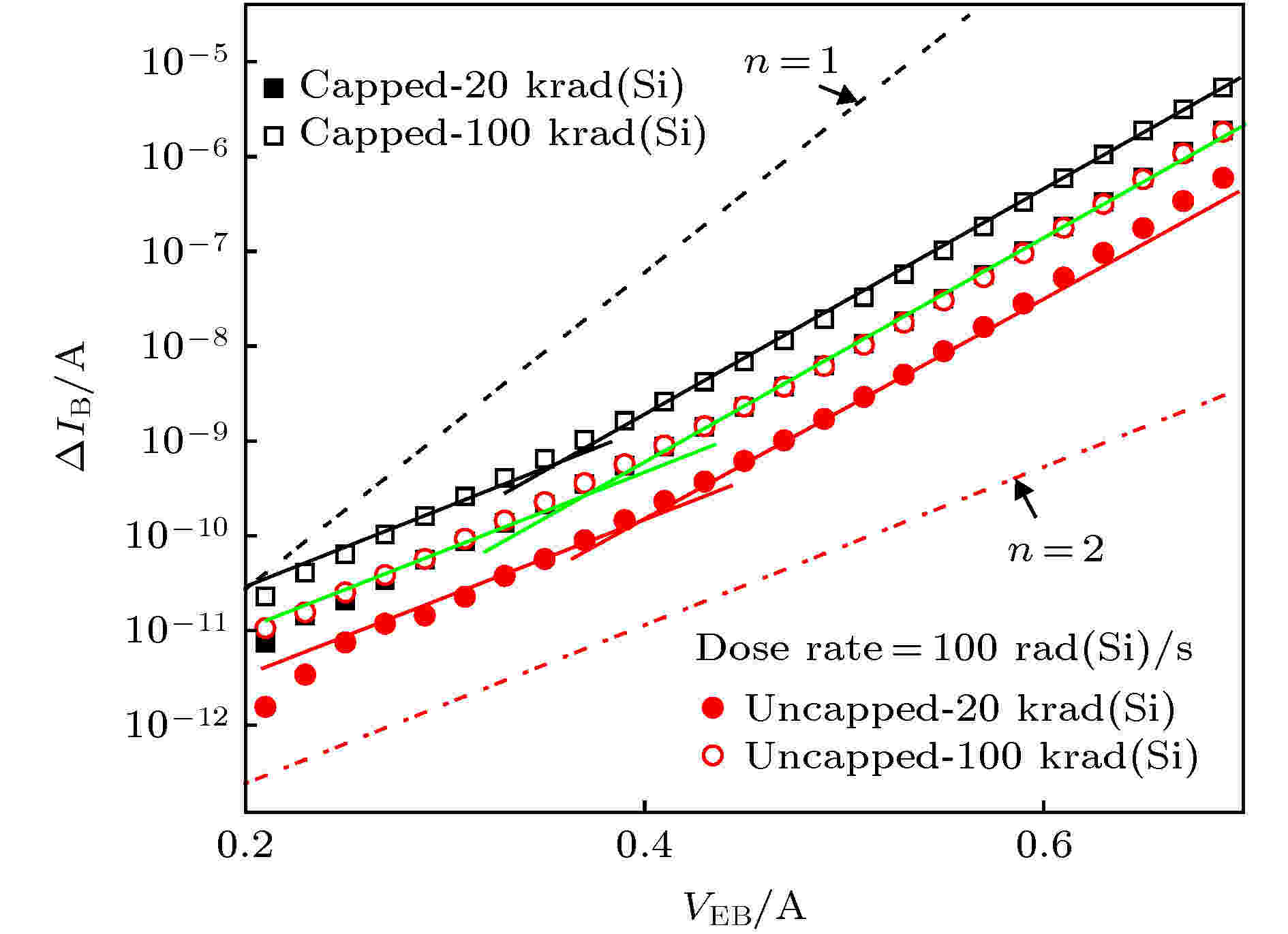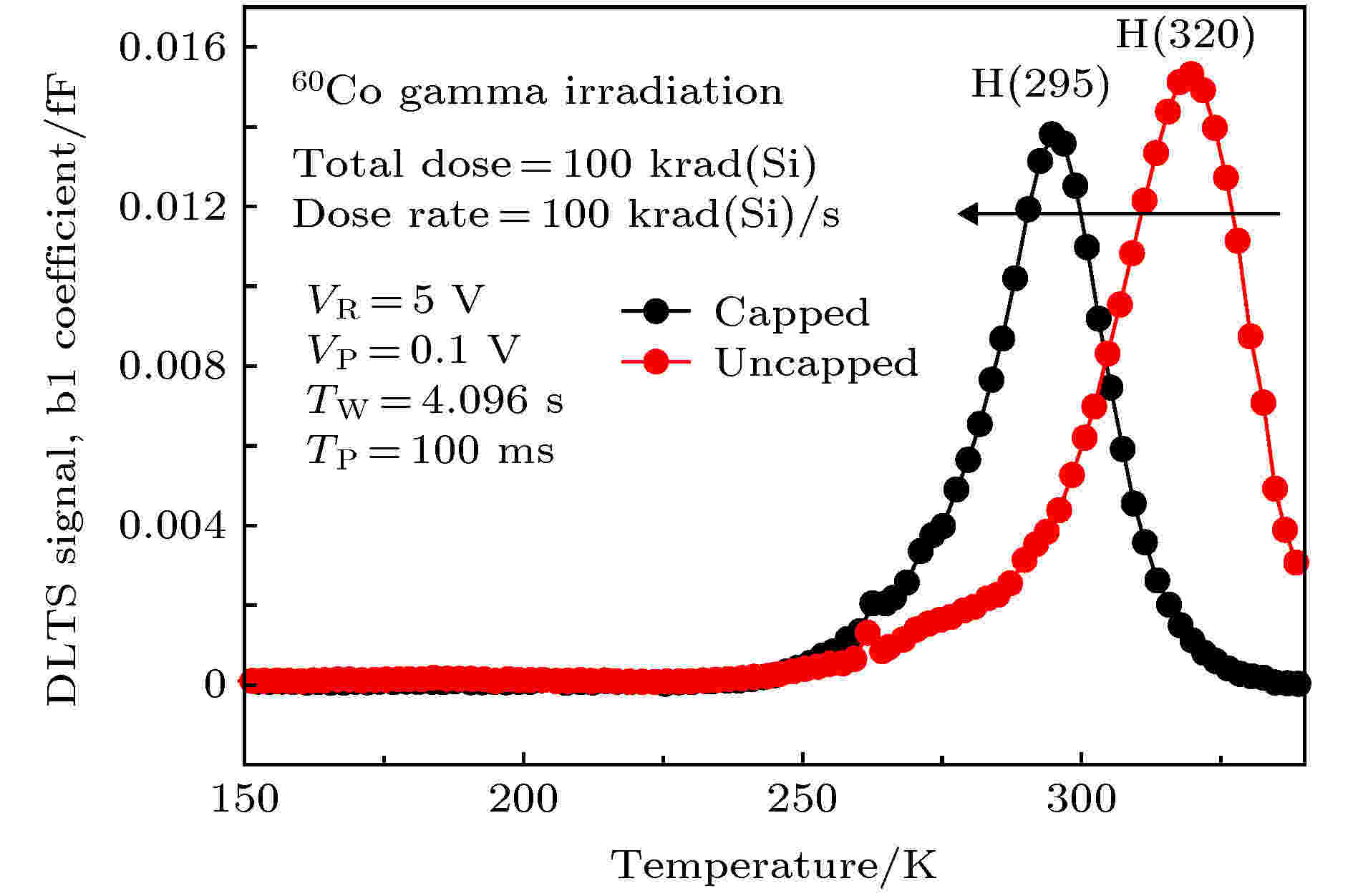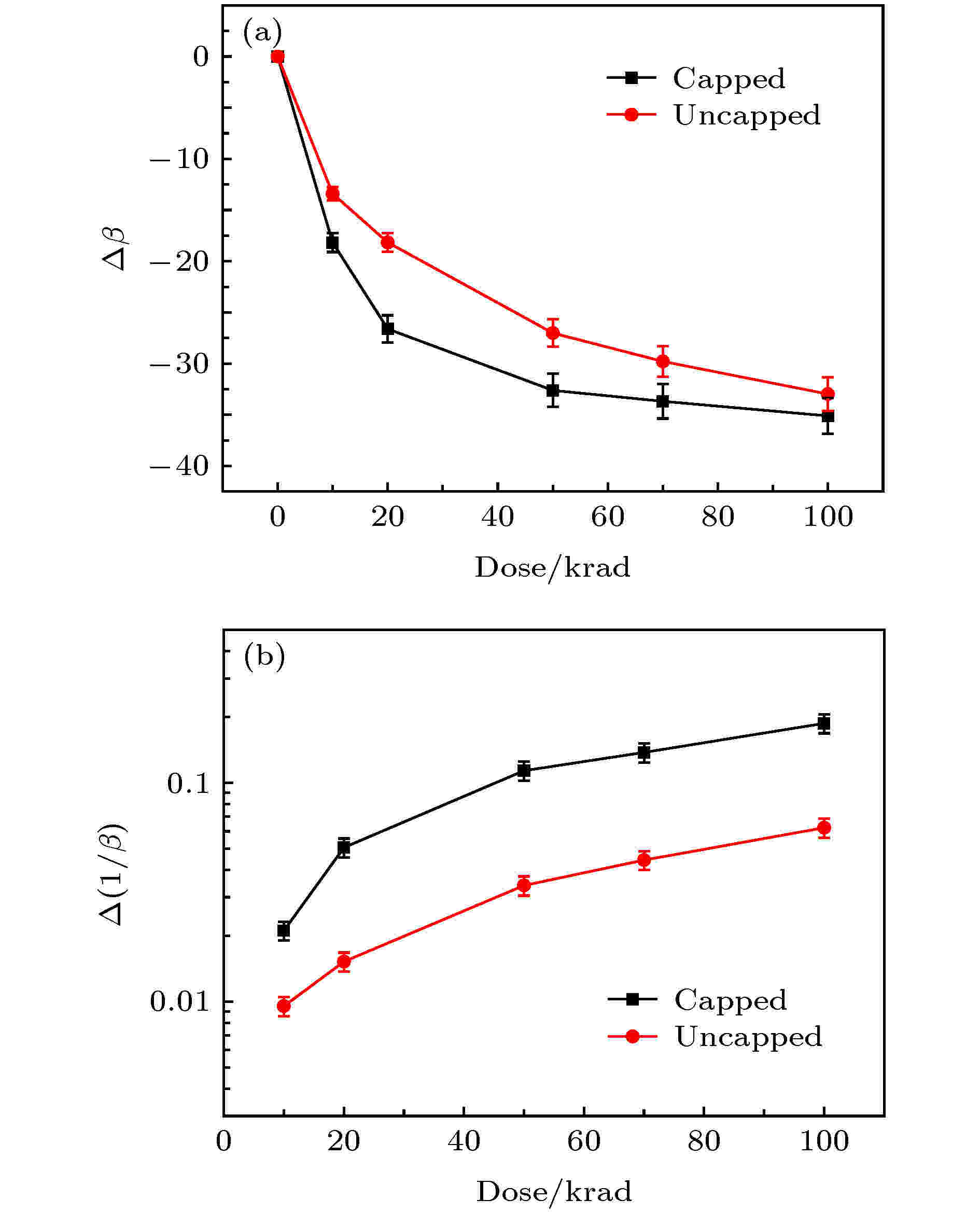全文HTML
--> --> -->电子元器件的生产封装过程中, 会不可避免的从外部引入杂质元素氢. 氢作为影响器件抗辐照能力的重要潜在因素, 国际上对此进行大量的研究. 目前在封装过程中普遍采用Kovar合金作为晶体管的金属帽材质, 通过残余气体分析 (RGA: residual gas analysis)对Kovar合金进行检测, 发现在器件空腔内含有1~2%的氢气存在, 而氢气的来源被普遍认为是在Kovar合金上的镀金过程中释放出来的[11-13].
器件在投入使用前会进行预加温处理进行优选, 即经过长时间加温过程将性能退化严重的器件筛选出来. 在预加温过程中升温会改变器件中氢的状态, 存在形式不同的氢均会对器件的电离效应产生关键性的影响作用[14-15]. 随着预辐照升温应力的增强, MOS器件及双极器件的电学性能退化或改善还与器件采用特定的工艺及测试条件等因素有着密切关系, 尚未有明确的规律.
通过研究发现, 预处理过程中器件对辐射效应的响应与器件的封装状态有关[16-18]. 研究表明: 在辐照过程中, 密闭环境下氢分子扩散在器件腔内并易与晶体管内金属及氧化物反应, 生成金属氢化物或含氢氧空位, 在辐照过程中参与促进界面态的形成, 对晶体管的电学性能造成影响; 温度会影响H+释放的数量, 而在一定温度条件下, SiO2层中氢气含量过高也会导致界面态发生退火. 因此, 辐照过程中界面态数量不光取决于H+释放的多少, 还与温度、氢气浓度以及含氢缺陷的数量等诸多因素有关. 目前各种因素的影响机制尚不清晰.预处理过程中有/无Kovar合金作为器件封装材料对器件内部氢的状态影响的研究结果表明, 双极晶体管的电离辐射特性与预加温处理及Kovar合金之间的相关性很密切, 然而, 目前国际尚未直接证明二者对双极晶体管电离辐射损伤的影响机制.深入开展预加温处理对开帽/未开帽双极晶体管电离辐射损伤机理研究, 可为寻求电子元器件抗辐射加固方法奠定有力基础, 具有重要的工程指导意义.
采用60Co γ射线做为辐照源, 针对横向PNP双极晶体管作为研究对象, 通过电学性能测试结合深能级缺陷分析, 深入研究预加温处理过程中, Kovar合金对LPNP晶体管电离辐射损伤的影响机制.
采用KEITHLEY 4200-SCS半导体参数仪, 对辐照前后LPNP晶体管进行Gummel曲线测试. 测试条件如下: 发射极接扫描电压, 从0.2 V扫描至0.8 V, 即VEB = 0.2—0.8 V, 扫描步长为0.01 V; 基极和集电极均接0 V电压, 即VB = VC = VBC = 0 V. 基于Gummel特性曲线还可以得出LPNP晶体管电流增益及其倒数的变化量随吸收剂量的变化关系, 以及晶体管过剩基极电流ΔIB随发射结电压VEB的变化关系来定性表征电离缺陷的演化规律.
基于深能级瞬态谱(DLTS)测试系统, 针对两种LPNP晶体管内部的微观缺陷状态进行分析, 深入分析LPNP晶体管电离辐照损伤微观机理. 选取晶体管中掺杂浓度较低的集电区进行测试, 测试参数设定如下: 反向偏压VR = 5 V, 脉冲电压VP = 0.1 V, 测试周期TW = 4.096 s, 脉冲宽度TP = 0.01 s, 测试的扫描温度为150—330 K.
3.1.电性能测试分析
对开帽/未开帽两种类型LPNP双极型晶体管Gummel特性曲线的对比情况如图1所示. 图中给出了在剂量率为100 rad(Si)/s的60Co γ射线辐照条件下, 晶体管的基极电流(IB)和集电极电流(IC)对电离效应影响的实验结果. 图1(a)描述的是LPNP晶体管IB随发射结电压VEB的变化情况. 随着吸收剂量的增加, 两种LPNP晶体管的IB逐渐增大, 此外, 与发射结电压VEB较大时相比, 当发射结电压VEB较小时, IB增加倍数较大. 图1(b)描述的是LPNP晶体管IC随发射结电压VEB的变化情况. 随着吸收剂量的增加, 两种预处理方式的LPNP晶体管IC均无明显变化. 图 1 剂量率100 rad(Si)/s条件下γ辐射吸收剂量对开帽/未开帽处理的LPNP双极型晶体管的 (a) IB 和 (b) IC 随VEB变化曲线的影响
图 1 剂量率100 rad(Si)/s条件下γ辐射吸收剂量对开帽/未开帽处理的LPNP双极型晶体管的 (a) IB 和 (b) IC 随VEB变化曲线的影响Figure1. Variations of (a) IB and (b) IC with base-emitter for the LPNP bipolar transistors with/without cap under dose rate of 100 rad(Si)/s with a 60Co gamma irradiation source.
前面的结果已经表明, 双极晶体管在受到电离辐射损伤后, IC基本上保持不变, 而电流增益退化的主要表现为IB增加. 通过探究辐照后双极晶体管的过剩基极电流(ΔIB)与发射结电压(VEB)的变化关系, 可以深入分析不同缺陷对双极晶体管电离辐射的作用机制, 从而得出预处理过程中Kovar合金对LPNP晶体管电离辐射效应的影响. 基极电流是载流子在基区扩散与复合形成的复合电流, 表达式为IB=IB-pre+ΔIB, 其中IB-pre为双极晶体管的初始基极电流值, ΔIB为基极电流的变化量, 也被称为双极晶体管的过剩基极电流.
针对双极晶体管的电离辐射损伤效应, 引入理想因子n, 理想情况下, 在辐照过程中, 如果器件复合类型以表面复合为主, 则理想因子n = 2. 表达式为
图2为相同剂量率Co60 γ辐照条件下, 两种LPNP晶体管的过剩基极电流ΔIB随发射结电压VEB的变化关系. 图中可以清楚看出, 随着吸收剂量的增加, 两种LPNP晶体管的ΔIB均明显增加; 而理想因子n随VEB变化呈现出两个斜率特征, 在VEB较小区段时, 理想因子趋于n = 2; 当VEB在较大区段 (VEB > 0.4 V) 时, 1 < n < 2. 理想因子n数值降低是由于基区表面辐射诱导界面态复合率的变化所导致的[19].
 图 2 60Co γ射线辐照条件下开帽/未开帽处理的LPNP双极晶体管基极电流变化量与发射结电压的关系
图 2 60Co γ射线辐照条件下开帽/未开帽处理的LPNP双极晶体管基极电流变化量与发射结电压的关系Figure2. Variations of ΔIB with VEB for the LPNP transistors with/without cap irradiated by 60Co gamma source.
通过LPNP晶体管ΔIB随发射结电压VEB的变化分析电离效应对LPNP晶体管基极电流的影响. 表达式为[19]
氧化物电荷的累积会导致空穴穿过耗尽层进入到中性基区, 再通过复合诱导理想因子n数值逐步趋近于1. 随着吸收剂量的增加, 界面态陷阱密度增加导致发射结耗尽区发生复合, 这也是产生ΔIB的重要原因. 其中ΔIB – VEB曲线斜率发生变化时所处发射结电压被定义为晶体管的转换电压Vtr. 界面态陷阱的不断累积, 不光会增加基极电流, 而且影响理想因子的数值变化, 转换电压逐渐降低. 这是由于随着吸收剂量的增加, 表面载流子浓度ns降低所引起的. 而ns降低的潜在因素是辐照过程中产生的带负电的界面态数量增多引起的静电效应[19], 或是氢在n型基区掺杂钝化作用所致[22].
从图2可以明显看出, 在相同辐照条件下, 预加温过程中未开帽处理的晶体管ΔIB变化更大, 且随着吸收剂量的增加, 转换电压Vtr明显向低发射结电压方向移动. 通过上述分析可知, n值的变化是由于界面态数量增多所导致的结果. 在辐照过程中, 与预加温过程中开帽处理的晶体管相比, 未开帽的LPNP晶体管n值变化程度更大, 说明器件内部产生的界面态更多, 分析认为未开帽晶体管中氢的浓度相对较高, 导致在n型基区掺杂钝化作用所引起的结果.
2
3.2.深能级缺陷分析
基于上述LPNP晶体管电性能结果分析可知, 导致晶体管电学性能退化的微观机制主要受界面态的影响. 现将两种LPNP晶体管中界面态缺陷信息进行对比, 通过深能级缺陷分析来验证上述试验结果. 图3为温度范围从150 K扫描到330 K、剂量率为100 rad(Si)/s条件的60Co γ辐照过程中, 两种LPNP晶体管DLTS谱的测试结果. 由图可见, 两种LPNP晶体管均在温度为250—330 K之间出现了一个明显的深能级缺陷信号峰. 由于缺陷信号峰峰尖所在的温度坐标不同, 将未开帽晶体管对应的信号峰命名为H(295), 将开帽晶体管对应的信号峰命名为H(320). 利用阿伦尼乌斯方程计算得出: 采用开帽处理的LPNP晶体管中的类深能级缺陷能级



 图 3 60Co γ射线辐照条件下, 有/无进行开帽处理的LPNP双极晶体管深能级瞬态谱图
图 3 60Co γ射线辐照条件下, 有/无进行开帽处理的LPNP双极晶体管深能级瞬态谱图Figure3. DLTS spectra of the LPNP transistors packaged with/without cap irradiated by 60Co gamma source.
本文中信号峰所处位置与文献[23]中的试验结果相似, 表明60Co γ射线辐照诱导LPNP双极型晶体管产生电离辐射损伤缺陷为界面态陷阱. 通常, 为了解释界面态陷阱的反应机制, 常采用Shaneyfelt等[24]提出的空穴/氢离子输运(HT)2模型. 该模型认为, 空穴向Si/SiO2界面传输时, 会在界面附近形成陷阱电荷. 随着空穴成为陷阱电荷或者被电子中和, 界面附近的氢原子可以在带正电的氧化物陷阱处形成氢离子, Si/SiO2界面附近的氢离子被释放, 传输到Si/SiO2界面的氢离子与界面发生相互作用, 同时生成界面态陷阱[25].
通过图3可以看出, 在相同辐照条件下, 与开帽处理过的LPNP晶体管相比, 未开帽处理的晶体管在辐照后DLTS特征峰向左移动, 表明辐照在未开帽处理的LPNP晶体管中引入的缺陷能级位置更接近禁带中心. 由肖克莱-里德-霍尔模型[26]可知, 缺陷能级位置越接近禁带中心, 则复合效率越高, 进而对晶体管造成的损伤越严重. 此外, 缺陷能级位置及缺陷浓度均是导致晶体管性能退化的重要因素, 我们之前研究已经证实, 与缺陷浓度相比, 缺陷能级位置占主导地位, 是使晶体管电学性能退化加剧的根本原因[27]. 通过上述分析可以说明预处理过程中未开帽处理LPNP晶体管内部受到电离辐射损伤更为严重.
基于上述分析, 通过探究LPNP双极晶体管电流增益变化量(Δβ)及其电流增益倒数变化量Δ(1/β)随吸收剂量的关系, 直观反映出辐照前后晶体管电性能变化规律, 为证明开帽处理对电离辐射损伤的影响机制, 揭示器件宏观电学性能退化与微观缺陷演化的对应关系. 电流增益β是表征双极晶体管辐射损伤效应最为重要的电性能参数. 本试验采取共发射极接线方式进行测试, 当发射结正偏电压VEB = 0.65 V时, IC与IB的比值定义为电流增益, 即β = IC/IB, 电流增益变化量的表达式为: Δβ = β-β0, 电流增益倒数变化量的表达式为: Δ(1/β)=1/β-1/β0, 式中β0和β分别为晶体管辐照前和辐照后的电流增益值. 图4(a)和图4(b)分别为相同剂量率60Co γ射线辐照条件下, 开帽/未开帽处理的LPNP晶体管Δβ和Δ(1/β)随吸收剂量的变化曲线. 如图所示, 对于两种类型的LPNP型晶体管而言, 随着吸收剂量的增加, LPNP晶体管的Δβ明显下降, 晶体管Δ(1/β)逐渐升高且退化无饱和趋势. 上述结果表明, 两种类型的LPNP晶体管均发生明显的电离辐射损伤. 其中, 在相同辐照条件下, 在预加温过程中未开帽处理的晶体管Δβ和Δ(1/β)退化程度更为明显.
 图 4 剂量率100 rad/s条件下γ辐射吸收剂量对开帽/未开帽处理的LPNP双极晶体管(a)电流增益变化量的影响和(b)电流增益倒数变化量的影响
图 4 剂量率100 rad/s条件下γ辐射吸收剂量对开帽/未开帽处理的LPNP双极晶体管(a)电流增益变化量的影响和(b)电流增益倒数变化量的影响Figure4. (a)The relationship between total dose and current gain for LPNP bipolar transistors with/without cap under dose rate of 100 rad (Si)/s with a 60Co gamma irradiation source. (b) The relationship between total dose and the reciprocal of current gain for LPNP bipolar transistors with/without cap under dose rate of 100 rad (Si)/s with a 60Co gamma irradiation source.
上述试验结果表明, 预加温过程中, 与开帽处理的LPNP晶体管相比, 未进行开帽处理的晶体管电性能退化严重, 在器件内部产生的界面态数量更多. 试验分析认为这是由于密封器件中含有大量的氢 (包括氢气、水汽), 晶体管的金属帽材质为Kovar合金, 其中氢气主要来源于Kovar合金内部吸附气氛在热应力作用下释放出来, 由于在密封环境中, 释放的氢气只能扩散在器件腔体内, 结合晶体管中金属材料形成金属氢化物, 在水汽的作用下, 加速器件的电性能退化程度. 与之相比, 非密闭晶体管内部不能保留氢气, 因此采用开帽处理的晶体管电性能更好.
1)两种类型LPNP晶体管的电学性能参数变化趋势相似, 辐照后晶体管IB随吸收剂量的增加逐渐增大, IC在辐照前后无明显的变化. Δ(1/β)均随吸收剂量的增加有明显的退化趋势, 其中, 未进行开帽处理过的LPNP晶体管电性能退化程度较大.
2)通过微观机理分析表明, 随着吸收剂量的增加, 未开帽处理的LPNP晶体管ΔIB增加明显, 理想因子n随VEB的增加逐渐降低, 转换电压Vtr明显向低发射结电压方向移动. 这是基区表面辐射诱导界面态复合率的变化所导致的, n值的变化是界面态数量增多所导致的结果. 通过DLTS谱分析可知, 与开帽处理过的LPNP晶体管相比, 电离辐射在未开帽晶体管内部产生的界面态能级位置更接近于禁带中心. 分析认为, 这主要由于密封器件中存在大量的氢气和水汽, 氢气的存在会促进界面态的形成, 而水汽会加剧器件电性能的退化程度. 与之相比, 开帽处理过的晶体管内部不能保留氢气, 因此晶体管电性能更好.
